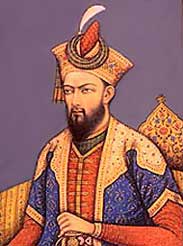The Mughal Empire
The last years of Shah Jahan’s reign were clouded by a bitter war of succession among his four sons – Dara Shikoh (crown prince), Shuja (governor of Bengal), Aurangazeb (governor of Deccan) and Murad Baksh (governor of Malwa and Gujarat). Towards the end of 1657, Shah Jahan fell ill at Delhi for some time but later recovered. But the princes started fighting for the Mughal throne.
Aurangazeb emerged victorious in this struggle. He entered the Agra fort after defeating Dara. He forced Shah Jahan to surrender. Shah Jahan was confined to the female apartments in the Agra fort and strictly put under vigil. But he was not ill-treated. Shah Jahan lived for eight long years lovingly nursed by his daughter Jahanara. He died in 1666 and buried beside his wife’s grave in the Taj Mahal.
 |
| Aurangazeb |
Aurangazeb was one of the ablest of the Mughal kings. He assumed the title Alamgir, World Conqueror. His military campaigns in his first ten years of reign were a great success. He suppressed the minor revolts. But he faced serious difficulties in the latter part of his reign. The Jats and Satnamis and also the Sikhs revolted against him. These revolts were induced by his harsh religious policy.
Deccan Policy
The Deccan policy of the Mughals started from the reign of Akbar, who conquered Khandesh and Berar. Jahangir fought against Malik Amber of Ahmadnagar. During the Shah Jahan’s reign, Aurangazeb, as governor of Deccan, followed an aggressive Deccan policy. When he became the Mughal emperor, for the first twenty five years, he concentrated on the northwest frontier. At that time, the Maratha ruler, Sivaji carved out an independent Maratha kingdom in the territories of north and south Konkan.
Information related to the search:
The Mughal Empire, mughal, shah, aurangazeb, india, reign, deccan, history, jahan, policy, governor, years, empire, first, revolts, maratha, fort, started, jahan&rsquo, succession, time, dara, agra

